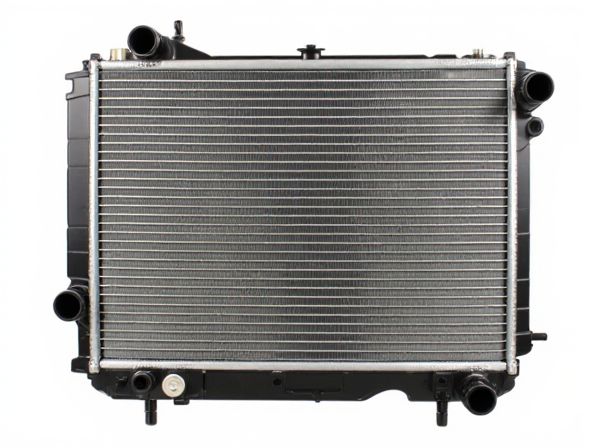
Photo illustration: Single Pass vs Dual Pass Radiator
Single pass radiators channel coolant through the radiator core in one continuous flow, promoting faster heat dissipation for standard cooling needs. Dual pass radiators route the coolant twice through the core, increasing contact time and improving cooling efficiency for high-performance or heavy-duty applications. You should choose a dual pass radiator if your system demands better heat management and enhanced temperature control.
Table of Comparison
| Feature | Single Pass Radiator | Dual Pass Radiator |
|---|---|---|
| Design | Coolant flows through radiator once | Coolant flows twice through radiator core |
| Cooling Efficiency | Moderate heat dissipation | Higher heat dissipation |
| Size | Generally larger core needed | More compact due to dual flow |
| Cost | Lower manufacturing cost | Higher manufacturing cost |
| Maintenance | Easier to maintain and clean | More complex cleaning due to dual pass |
| Best Use | Standard cooling needs | High-performance or heavy-duty cooling |
Introduction to Radiator Pass Types
Radiator pass types influence heat exchange efficiency in cooling systems, with single pass radiators directing coolant through one continuous channel, allowing straightforward flow and simpler design. Dual pass radiators route coolant through the core twice by splitting the flow path, enhancing heat dissipation by increasing the coolant's exposure time within the radiator. Understanding these pass types is crucial for optimizing radiator performance in automotive and industrial cooling applications.
What is a Single Pass Radiator?
A single pass radiator features coolant flowing through the radiator core only once, enabling faster heat dissipation by maximizing coolant speed and reducing thermal resistance. This design typically results in simpler construction, lower cost, and lower pressure drop compared to dual pass radiators. Single pass radiators are commonly used in applications requiring efficient cooling with minimal fluid resistance.
What is a Dual Pass Radiator?
A dual pass radiator features a design where coolant flows through the radiator core twice, enhancing heat exchange efficiency compared to single pass radiators. This configuration improves thermal performance by increasing coolant contact time with cooling fins, allowing better dissipation of engine heat. Dual pass radiators are ideal for high-performance or heavy-duty vehicles requiring superior cooling capacity.
Key Differences between Single Pass and Dual Pass Radiators
Single pass radiators feature coolant flowing through the radiator core once, providing straightforward heat exchange but generally lower cooling efficiency. Dual pass radiators route the coolant through the core twice via an internal partition, effectively increasing surface contact time and improving overall heat dissipation. The increased complexity and size of dual pass radiators typically result in enhanced thermal performance compared to single pass designs.
Cooling Efficiency: Single Pass vs Dual Pass
Dual pass radiators provide enhanced cooling efficiency by forcing the coolant to flow through the radiator core twice, increasing heat dissipation compared to single pass designs where coolant passes once through the core. The extended path and higher turbulence in dual pass radiators improve thermal transfer, resulting in lower engine temperatures under heavy loads. Single pass radiators typically offer simpler flow and lower pressure drops but may struggle to maintain optimal cooling in high-performance or demanding conditions.
Installation Considerations for Each Type
Single pass radiators feature straightforward installation requiring fewer inlet and outlet ports, making them suitable for compact setups with limited piping complexity. Dual pass radiators need more precise plumbing to ensure coolant flows through both passes correctly, demanding careful alignment of inlet and outlet positions to avoid installation errors. Installing dual pass units often requires additional space and expertise to manage the more intricate coolant routing compared to single pass systems.
Performance Impact in Automotive Applications
Single pass radiators circulate coolant through one continuous path, limiting heat dissipation speed but offering simpler design and lower manufacturing costs. Dual pass radiators force coolant to traverse two segments in series, increasing the coolant's exposure time to airflow and enhancing thermal transfer efficiency by up to 15-20%. This improved heat rejection in dual pass systems directly impacts automotive engine performance by maintaining optimal operating temperatures under high load conditions, thereby reducing the risk of overheating and improving fuel efficiency.
Cost Comparison of Single Pass vs Dual Pass Radiators
Single pass radiators generally have a lower upfront cost due to simpler design and reduced material usage compared to dual pass radiators. Dual pass radiators, however, offer higher efficiency and improved heat exchange, which can lead to energy savings that offset the initial investment over time. The choice between single pass and dual pass radiators should consider both initial budget constraints and long-term operational costs for optimal value.
Pros and Cons: Single Pass vs Dual Pass
Single pass radiators offer simpler construction and lower cost, making them ideal for basic heating systems, but they can have lower heat transfer efficiency due to limited coolant flow paths. Dual pass radiators improve heat dissipation by forcing coolant to pass through the radiator twice, enhancing thermal performance and engine cooling but increasing system complexity and cost. Single pass radiators are suited for lighter-duty applications, while dual pass radiators are preferred in high-performance or heavy-duty scenarios where optimal cooling is crucial.
Choosing the Right Radiator for Your Needs
Single pass radiators circulate coolant through the core once, providing faster heat transfer ideal for compact engine bays and moderate cooling demands. Dual pass radiators route coolant twice through the core, significantly increasing heat dissipation efficiency, making them suitable for high-performance engines or extreme conditions. Selecting the right radiator depends on factors such as engine size, operating temperature, vehicle use, and available space, balancing cooling capacity with system complexity.
 caratoz.com
caratoz.com